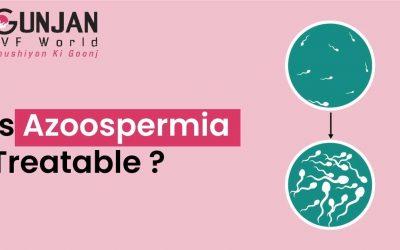Overview
When you are trying to conceive for more than 12 months, but are unsuccessful, then one of you is suffering from infertility. Worldwide, about 1/3 rd the couples with infertility are impacted by male infertility. Approximately, 1% of the total global population & ~10 to 15% of Infertile males are diagnosed with azoospermia.
To get pregnant, the normal sperm count should be between 15 to 39 million per ml of semen ejaculated. If the sperm count is below 15 million per ml of semen, then the condition is characterized as ‘Low sperm count’. Moreover, if the sperm count is zero i.e. there is a complete absence of sperm count in the semen, then the condition is called ‘Azoospermia’.
Chances are you’re familiar with the term “azoospermia.” It’s a common condition that affects men’s fertility. In this blog post, we’ll explore and understand the causes of azoospermia in detail and provide some tips on how to overcome this condition. So, stay tuned!

Types of azoospermia & underlying causes
As mentioned earlier, Azoospermia is defined as the complete absence of sperm in the ejaculate. In order to be diagnosed with azoospermia, a man must have two sperm count tests that show zero sperm.
Azoospermia affects about 1% of all men and 10-15% of infertile men. There are 3 main types of Azoospermia. Let’s discuss each of them and their causes in detail.
1. Pre-testicular azoospermia:
This type of azoospermia is caused by problems with the hormones that control sperm production. Hormonal imbalances can be caused by genetic disorders, tumors, infections, or other health conditions.
Some of the common causes of pre-testicular azoospermia include:
- Kallaman syndrome
Kallmann syndrome is a condition that affects the development of puberty and the sense of smell. The exact cause of Kallmann syndrome is unknown, but it is thought to be caused by a problem with the hormones that control sexual development.
People with Kallmann syndrome usually have a delayed pubertal onset and anosmia (lack of sense of smell). Kallmann syndrome is a rare condition, affecting 1 in 10,000 people. There is no cure for Kallmann syndrome, but treatment can help to manage the symptoms.
- Pituitary gland tumours
Tumors of the pituitary gland can interfere with the production of hormones that control sperm production.
- Infections
Infections, of the hypothalamus or pituitary gland can lead to decrease hormone production as thus azoospermia
- Chromosomal defects
Certain chromosomal defects, such as kallaman syndrome, single gene disprders, can cause hormonal imbalances that impact sperm production.
- Pituitary gland cancer
Pituitary gland cancer can damage hormone production and thus sperm production .
2. Testicular azoospermia:
Testicular azoospermia is the most common type of azoospermia and is caused by damage to the testicles. This damage can be caused by genetic disorders, infections, tumors, or injury to the testicles. Some of the common causes of testicular azoospermia include:
- Klinefelter syndrome
Klinefelter syndrome is a genetic disorder that affects men. Men with Klinefelter syndrome have an extra copy of the X chromosome, which can lead to testicular damage.
- Infections
Infections, such as mumps orchitis, can damage the testicles and hinder sperm production.
- Testicular cancer
Testicular cancer can damage the testicles and hinder sperm production.
- Undescended testicles
If the testicles do not descend into the scrotum, they may be damaged by the higher temperatures in the body. This can lead to reduced sperm production.
3. Post-testicular azoospermia:
This type of azoospermia is caused by blockages in the tubes that carry sperm from the testicles to the penis. Blockages can be caused by infection, injury, or surgery. Some of the common causes of post-testicular azoospermia include:
- Epididymitis
Epididymitis is an inflammation of the epididymis, the tube that carries sperm from the testicles to the vas deferens. Epididymitis can be caused by infection or injury.
- Vasectomy
A vasectomy is a surgical procedure that cuts the vas deferens, the tube that carries sperm from the testicles to the penis. A vasectomy can be reversed, but it is not always successful.
- Cystic Fibrosis
Cystic fibrosis is a genetic disorder that affects the lungs and digestive system. Men with cystic fibrosis often have blockages in the vas deferens.
- Spermatocele
A spermatocele is a cyst that forms on the epididymis, the tube that carries sperm from the testicles to the vas deferens. A spermatocele can block the flow of travel of sperm through the epididymis.
- Inguinal hernia
An inguinal hernia can cause a blockage in the vas deferens, the tube that carries sperm from the testicles to the penis. An inguinal hernia occurs when a portion of the intestine bulges through a weak spot in the abdominal wall.
- Retrograde ejaculation
Retrograde ejaculation is a condition in which sperm are ejected into the bladder instead of out through the penis. Retrograde ejaculation can be caused by certain medications, diabetes, or surgery of the bladder, prostate, or urethra.
Our ratings
Book An Appointment
Follow Us On
What are the risk factors for Azoospermia?
There are several risk factors that can increase a man’s chances of developing azoospermia. These risk factors include:
- Age
The older a man is, the greater his risk of developing azoospermia. This is because sperm production declines with age.
- Family history
If a man has a family history of azoospermia, he has an increased risk of developing the condition himself.
- History of infections
Men who have had infections, such as mumps orchitis, have an increased risk of developing azoospermia.
- Testicular cancer
Men who have had testicular cancer have an increased risk of developing azoospermia.
- Testicular injury
Men who have had an injury to the testicles have an increased risk of developing azoospermia.
- Undescended testicles
Men who have undescended testicles have an increased risk of developing azoospermia.
- Varicocele
A varicocele is a condition in which the veins in the scrotum are enlarged. Men with a varicocele have an increased risk of developing azoospermia.
- Environmental toxins
Exposure to certain environmental toxins, such as pesticides, can increase a man’s risk of developing azoospermia.
How is Azoospermia diagnosed?
Azoospermia can be diagnosed with a physical exam and a semen analysis. A physical exam can help to rule out other conditions that may cause infertility. A semen analysis is the most accurate way to diagnose azoospermia.
During a semen analysis, a sample of semen is collected and analyzed for sperm. If no sperm are found in the semen, azoospermia is diagnosed.
20+ Years Of Experience as Fertility Specialists
20 Years Of Experience as a Fertility Specialists
National Fertility Awards 2023
Call Us
+919990044555
Final Thoughts
Azoospermia can cause infertility. If azoospermia is not treated, it may be impossible for a couple to conceive a child naturally. Azoospermia can also cause emotional stress and strain on a relationship. Couples who are struggling with infertility may experience anxiety, depression, and relationship problems.
The treatment for azoospermia depends on the underlying cause. If azoospermia is caused by an obstruction, surgery may be needed to correct the obstruction. If azoospermia is caused by a hormonal imbalance, hormone therapy may be used to correct the imbalance.
In some cases, azoospermia cannot be treated and IVF/ICSI is the only option for conception. During IVF, eggs are collected from the woman and fertilized with sperm in a laboratory. The fertilized eggs are then implanted in the woman’s uterus.
If you are struggling with infertility, it is important to talk to our doctor about your options. We offer the latest technology in azoospermia treatment in Delhi, India. IVF/ICSI may be the only option for couples who are unable to conceive naturally.
Share this with
Related Blogs
Is Azoospermia Treatable
Infertility is a serious problem not only in India but across the world as well. That is why it is really important to go for some alternative procedures of reproduction.
Can You Get Pregnant With Azoospermia?
Many factors can affect natural pregnancy chances, and one such factor is azoospermia. It is hard for a woman to get pregnant naturally if her husband has azoospermia (absence of sperm in the semen).
Follow Us On
About Author









